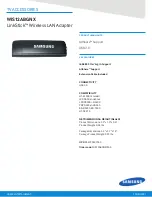
Extended functions
BK3xx0
74
Version: 4.3.0
Assigning the Bus Terminals to freely chosen process image addresses
Because digital terminals are always grouped into bytes, which therefore means that the smallest DP
configuration module is an 8-bit module, a difficulty arises when the associated terminals are to be
distributed over a number of bytes in the PLC process image. This is because in the PLC it is usually only
possible to assign addresses for each DP configuration module. With multi-configuration mode it is now
possible to configure additional digital terminals as "dummy" terminals at any desired locations, enabling the
address offsets of the other terminals to be shifted in the PLC process image.
Setting the multi-configuration mode
Multi-configuration mode is activated via the
Byte
Bit
Description
3
4
1: Multi-configuration mode is active
Rules for multi-configuration mode
Multi-configuration mode requires a few additional rules to be observed, in addition to those for standard
configuration:
• Only one DP module may be configured for each analog terminal
• The digital terminals are to be declared as KLxxxx Multi-Cfg mode modules at their true position
• The digital terminals are to be declared after the analog modules moreover as input/output sum
modules, corresponding to their bit width, as is also the case for standard configuration in the process
image.
• All modules for the maximum configuration, including the reserve modules, are to be declared
• Modules that are not inserted must be disabled
Enabling/disabling Bus Terminals
Those Bus Terminals that are present in the DP configuration, but that are not in fact plugged in, must be
disabled. This can be done in the
, via DPV1, KS2000 or through the 2-byte PLC
interface.
Making the setting through DPV1 or through the 2-byte PLC interface has the advantage that the terminal
assignment for the multi-configuration mode can usually be made directly from the PLC program, without
having to change the DP configuration of the master.
As long as the inserted Bus Terminals do not agree with the non-disabled Bus Terminals to be expected
from the DP configuration, the Bus Terminal will normally set the
Stat_Diag
bit in the diagnostic data, with
the consequence that it is not yet ready for cyclic data exchange.
If, however, the enabling and disabling is to be carried out via the 2-byte PLC interface, it is a precondition
for function of the 2-byte PLC interface that the coupler is in cyclic data exchange mode. For that reason it is
also possible to deactivate remaining in the
Stat_Diag
state:
Byte
Bit
Description
3
6
1: In multi-configuration mode the coupler also enters the data exchange even when
the configuration is not consistent, although K-bus cycles are not yet executed
Enabling/disabling via UserPrmData
The assignment of the terminals (a maximum of 128 terminals is possible) is entered from byte 15 to byte 30
and from byte 41 to byte 56 of the
. Two bits are reserved here for each terminal,
indicating whether the relevant terminal is enabled (value 0) or disabled (value 2). If the UserPrmData is to
be displayed as text in the DP configuration tool, then the parameters
Assignment of module x
are to be set
to
DP DataExchange (enabled)
or
Multi-Config. mode (disabled)
.
















































